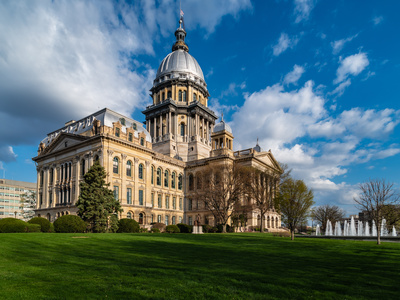-000055-400px.jpeg)
Tax & Budgets, Health Care & Wellness
Here’s How States Are Responding to Trump’s One Big Beautiful Bill Act
October 8, 2025 | Abbie Telgenhof, Morgan Scarboro
January 17, 2022 | Neal Osten, Morgan Scarboro, Ryan Maness

Key Takeaways:
As states kick off their 2022 legislative sessions, here are some of the main topics we expect lawmakers to explore in the area of tax and budgets. This post is part of our series on state policy issues to watch in 2022 (click here to see all issues areas).
Background: Since May of 2020, state and local governments received over $1 trillion in federal funds in four stimulus relief packages passed by Congress to offset the costs incurred by the pandemic shutdown and to promote economic growth. The last stimulus package, the American Rescue Plan Act (ARPA) enacted in March of 2021, provided $1.9 trillion in stimulus funds, including $673 billion in direct and targeted aid to state and local governments. The State and Local Coronavirus Relief Fund in ARPA provides $350 billion to state ($195.3 Billion) and local ($130.2 billion) governments.
Why It's Trending: On May 21, 2021, the Treasury Department started the process of sending $219.7 billion to state and local governments, and the remaining $105.8 billion will be distributed in May of 2022. As the funds were delivered after most state legislatures adjourned for the year, the process to authorize the spending of these funds was slower than the the Biden Administration had hoped. However, several states have held special sessions to appropriate ARPA funds. As state and local governments will receive the second tranche of funds in May 2022, the spending of ARPA funds will continue to be a priority for many state legislatures during next year’s legislative sessions.
Current Landscape: According to NCSL, 41 states have authorized spending some portion of their Coronavirus Relief Funds (CRF). States have until December 31, 2024, to authorize spending of their CRF allocations and until December 31, 2026, to actually spend the funds. CRF money not spent by that date reverts back to the Treasury Department. States are using the funds for varied programs so far, including $15.2 billion to replenish Unemployment Trust Funds; $12.7 billion for state administration; $8.9 billion for public health; $5.1 billion for education; $3.7 billion for housing; $3.1 billion for broadband expansion; and the list goes on to cover infrastructure, environmental needs, economic development, human services, arts and culture, and criminal justice concerns.
2022 Outlook: As states legislatures convene for the 2022 legislative sessions, legislators will continue to consider the authorization of ARPA funds, most likely as part of the states’ budget process. It is expected that additional states will make efforts to replenish their Unemployment Trust Funds to avoid having to raise unemployment taxes on businesses. Another area to watch will be to see if the states will be allowed to use ARPA funds for tax reductions. Before final passage of ARPA, the Senate included an amendment to prohibit states from using ARPA funds to reduce state taxes. This was immediately challenged as unconstitutional by state attorneys general from around the country. A federal district court recently ruled that Congress overstepped its authority under the Spending Clause of the U.S. Constitution by stating that states could not use the federal ARPA funding to reduce taxes. This ruling only applies to only the following states: Alabama, Alaska, Arkansas, Florida, Iowa, Kansas, Montana, New Hampshire, Oklahoma, South Carolina, South Dakota, Utah, and West Virginia. Ohio previously won a similar outcome in its lawsuit against the Treasury Department. There are four other cases presently pending in federal courts. It is expected that these cases will be settled in the U.S. Supreme Court.
Background: Legislators on both sides of the aisle have contemplated ways to levy punitive taxes on the “tech industry” for years, albeit for different reasons. Tech taxes refer generally to taxes on large companies seen as existing primarily in the digital or information technology space, including taxes on data and digital advertising. The scope of these policies, however, often extend far beyond big tech companies and often would result in levies on a wide array of industries, both large and small, and thus would pyramid throughout the economy.
Why It's Trending: “Big tech” has been under scrutiny from both federal and state legislators in recent years; however, legislators previously focused on issues like privacy and content moderation, not tax issues. Things changed when a New York Times op-ed from economist Paul Romer proposed “new legislation could establish a tax that would encourage platform companies to shift toward a healthier, more traditional model.” A few state lawmakers pivoted to focus on the tax angle, with Maryland leading the pack in enacting a digital advertising tax (the only state to date to enact a tax allegedly targeted at tech, although the actual impact would fall on businesses of all kinds, large and small).
Current Landscape: Many are of the opinion that the Maryland tax violates the federal Permanent Internet Tax Freedom Act and also one or more provisions of the U.S. Constitution; two lawsuits are pending regarding the tax. Seven states proposed similar taxes on digital advertising, and Connecticut and Massachusetts seriously considered the tax, but no other states have enacted such a tax. Different types of taxes purportedly focused on the technology sector were also considered, such as New York’s “severance tax” on data collection — another broad tax that would impact many types of businesses. No state enacted a tax on data collection, but we expect various types of so-called tech taxes to be floated again in 2022.
2022 Outlook: It’s likely that states will wait and see what happens with the Maryland digital advertising tax litigation before taking any action of their own. However, the conversation about taxing “big tech” will continue as legislators are still concerned about the issue, so other taxes on tech will be introduced in 2022. As the issue has supporters on both sides of the aisle and the taxes are introduced as punitive measures and not revenue raisers, it’s tough to predict which states will take them up.
Background: The elimination of the individual income tax has always been the policy goal of a certain set of state lawmakers, but that cohort appears to be expanding due to political realignments and strengthening fiscal conditions. Currently, politicians pursuing the elimination of the tax are not seeking to replace any lost revenue by means of a tax swap, but over the long-term that could change. A strengthened sales tax — either by raising the rate or expanding the base — are among the likeliest options.
Why It's Trending: Two things account for the increased interest in eliminating the personal income tax. First, West Virginia Governor Justice (R) made a full-throated push to eliminate the personal income tax this year, arguing that it was essential for the state to remain competitive with its neighbors. The effort was ultimately unsuccessful, but it attracted real support within some corners of the GOP and not just within the state. Second, state budgets are historically strong and conservative leaders want to capitalize on this moment.
Current Landscape: Mississippi Governor Reeves (R) included personal income tax elimination as part of his executive budget recommendation, saying that the state’s budget was strong enough to not require the raising of any additional revenues. Former Maine Governor LePage (R) has made the tax’s elimination a key part of his reelection campaign. If these efforts are successful they will join eight other states that currently do not levy any form of personal income tax: Alaska, Florida, Nevada, South Dakota, Tennessee, Texas, Washington, and Wyoming.
2022 Outlook: It’s hard to say how many more states could join Governor Reeves and former-Governor LePage, but given the current state of the parties and the economic conditions it seems likely that there will be others. If these are or other efforts are successful, attempts to levy more robust consumption taxes could follow close behind.
This post is part of our series on state policy issues to watch in 2022 (click here to see all issues areas).
-000055-400px.jpeg)
October 8, 2025 | Abbie Telgenhof, Morgan Scarboro

August 5, 2025 | Morgan Scarboro

July 30, 2025 | Bill Kramer